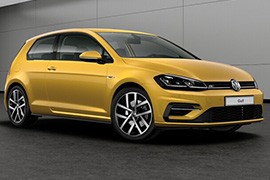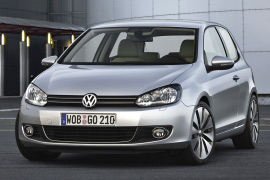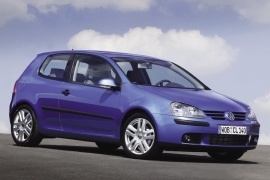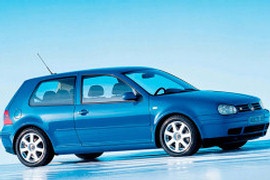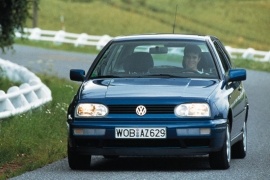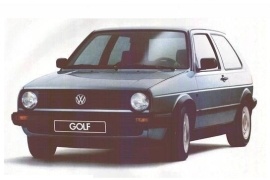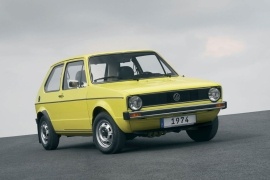VOLKSWAGEN Golf 3 Doors Models/Series Timeline, Specifications & Photos
First production year: 1974
Engines: Gasoline, Diesel, Natural gas
Body style: Hatchback
Volkswagen introduced the seventh generation of the well-known Golf hatchback in 2012, and five years later, in 2017, it brought the facelifted version for it.
Available in a few bodywork versions, the Golf VII still retained the three-door hatchback version that made it famous back in the '70s when it introduced the lineup with the Golf I. The 2017 model received more upgrades, mostly on the technical side but also on the car's appearance. Volkswagen built it on top of the MQB platform used on all of its brands (Volkswagen, Audi, Seat, and Skoda). In 2017, the German carmaker introduced a facelifted version of the Golf VII.
Its sharper look was far more distinct than on the sixth-generation model. The angular headlights featured LED daytime running lights inside them, and Volkswagen offered an option for Full-LED headlamps. The narrow grille between them sported two slim slats and the chromed VW badge. A trapezoidal-shaped lower grille in the bumper made the car looks more aggressive. Like its predecessors, the three-door version featured longer doors to ease ingress and egress to the car for the rear passengers. At the back, all trim levels received LED taillights.
Inside, the carmaker installed an interior that looked more premium than mass-market. Volkswagen improved the materials on the soft-touch dashboard, the upholstery, and the center stack. As an option, the Golf VII featured a 12.3" digital instrument cluster. A new, Discover-Pro, 9.2" touch-screen became available on the options list, enhancing the driving experience.
Under the hood, Volkswagen installed Euro 6 compliant engines ranging between 85 hp and 150 hp, either gasoline or diesel. All versions were turbocharged. For the transmission, the carmaker opted for either a six-speed manual or a seven-speed automatic (double-clutch) gearbox.
VOLKSWAGEN Golf VII 3 Doors 1.0L TSI 5MT (85 HP)
VOLKSWAGEN Golf VII 3 Doors 1.0L TSI 6MT (110 HP)
VOLKSWAGEN Golf VII 3 Doors 1.0L TSI 7AT (110 HP)
VOLKSWAGEN Golf VII 3 Doors 1.4L TSI 6MT (125 HP)
VOLKSWAGEN Golf VII 3 Doors 1.4L TSI 6MT (150 HP)
Volkswagen introduced the seventh generation of the Golf in Berlin for a special event in 2012 with two body versions, including the three-door one that attracted customers since the first Golf's generation.
The Golf began its journey back in the early '70s and continued to be a successful model. Its worldwide sales and various options and engine choices made it one of the world's best-selling cars. For the 2012 model, the German carmaker decided to keep the older MQB platform used by the Golf MK VI but slightly enhanced on several components.
Its sharp-looking angled headlights, narrower on the inside, showed a slightly aggressive styling. A silver strip crossed the grille at the bottom into the headlights, making it a distinctive feature for the seventh generation. Its three-door version featured longer doors for easier ingress and egress to the car and fixed rear windows.
Inside, the interior was more driver-oriented. Its central console was tilted more toward the driver, with easier access to the buttons and infotainment system. It featured a standard 5.8" touchscreen display while an 8" unit with a navigation system was on the options list. The air-conditioning was standard from the base level, with an option for automatic climate control.
Volkswagen installed a semi-rigid rear axle on the vehicles fitted with engines under 115 hp diesel and 125 hp gasoline, and independent for the others.
VOLKSWAGEN Golf VII 3 Doors 1.2L TSI 5MT FWD (85 HP)
VOLKSWAGEN Golf VII 3 Doors 1.2L TSI 6MT FWD (110 HP)
VOLKSWAGEN Golf VII 3 Doors 1.2L TSI 7AT FWD (110 HP)
VOLKSWAGEN Golf VII 3 Doors 1.4L TSI 6MT FWD (125 HP)
VOLKSWAGEN Golf VII 3 Doors 1.4L TSI 6MT FWD (150 HP)
VOLKSWAGEN Golf VII 3 Doors 1.4L TSI 7AT FWD (125 HP)
VOLKSWAGEN Golf VII 3 Doors 1.4L TSI 7AT FWD (150 HP)
VOLKSWAGEN Golf VII 3 Doors 1.4L TSI ACT 6MT FWD (150 HP)
The sixth generation of the Golf was introduced in 2008 in both forms, as a 3- or 5-door hatchback. While it resembled some design cues from its predecessor, it was a completely new car.
As Mr. Walter de Silva, head of design stated, the challenge was “to create an iconic car for the future”. The Italian was put in charge of the Volkswagen design department in February 2007. His involvement was important since he added the final touches to the car.
From the outside, the 2008 Golf featured a three-slats design for the grille and rounded swept-back headlights. The apron was complemented with the fog-lights on the outboard and a wide, trapezoidal, black grille. With its ascending beltline, that was stretched between the front wheel-arches and the taillights, the Golf offered the same dynamic image as its predecessors.
The instrument cluster featured a new design, inspired by the Passat CC. It featured two big dials and two smaller ones, placed inside the former ones. A center stack with the infotainment system and a big area reserved for the climate controls, inspired by the VW Passat CC. The bucket-seats were typical for the entire Volkswagen range. Other sport-seats were on the options list, depending on the trim level. In the back, there was a decent amount of legroom and headroom, with up to 979 mm (38.5”) between the seats and the ceiling.
Apart from the GTI version, the rest of the range was offered with a wide choice of engines. There were 5 gasoline units, 5 turbodiesels, and 1 with CNG. The latter was fit for fleet users. Depending on the engine, the standard transmission was a 5- or 6-speed manual. A 7-speed automatic was offered for diesel and gasoline versions. The 4Motion, all-wheel-drive system was on the options list as well.
VOLKSWAGEN Golf VI 3 Doors 1.4L 16V 5MT (80 HP)
VOLKSWAGEN Golf VI 3 Doors 1.4L TSI 6MT (122 HP)
VOLKSWAGEN Golf VI 3 Doors 1.4L TSI 6MT (160 HP)
VOLKSWAGEN Golf VI 3 Doors 1.4L TSI 7AT (122 HP)
VOLKSWAGEN Golf VI 3 Doors 1.4L TSI 7AT (160 HP)
VOLKSWAGEN Golf VI 3 Doors 1.6L TDI 5MT (105 HP)
VOLKSWAGEN Golf VI 3 Doors 1.6L TDI 5MT (90 HP)
VOLKSWAGEN Golf VI 3 Doors 1.6L TDI 7AT (105 HP)
VOLKSWAGEN Golf VI 3 Doors 2.0L TDI 4MOTION 6MT (140 HP)
VOLKSWAGEN Golf VI 3 Doors 2.0L TDI 5MT (110 HP)
VOLKSWAGEN Golf VI 3 Doors 2.0L TDI 6AT (110 HP)
The Golf stormed the 2003 Frankfurt Motor Show doors in two body-shapes, ending the six-year production period of its predecessor.
While its five-door sibling was most wanted as fleet cars and young families, the three-door model was the most expected version by those who didn't really need rear seats other than a temporary storage area. It was also the version that brought the first GTI and invented the hot-hatch segment.
Like its predecessor, it featured clear-lenses over the dual headlamps and turn-signal as a light-strip at the bottom of them. The grille featured two slats that supported the chromed badge big enough to fill the space between the hood and the bumper. On its sides, the carmaker dropped the fender-mounted turn-signals and moved them to the door-mirrors assembly. Like its predecessor, the three-door version featured fixed rear side windows without an option for a pop-out venting system.
Inside, Volkswagen offered a two-tone interior only for specific versions, while the Trend trim-level featured only the bland black-and-gray color scheme. Its flat seats offered as standard didn't provide too much grip for their occupants, but Volkswagen offered a better pair for extra money. In the back, the split-folding rear bench seatback could expand the trunk area.
Under the hood, Volkswagen installed a very wide range of engines for the Golf. It offered both gasoline and turbo-diesel units. The latter were blamed for their fake results in the Emission tests that started the Dieselgate scandal. Apart from the GTI version, its most powerful engine was a 2.0-liter turbo-diesel that offered 170 hp, while the most potent gasoline unit delivered 20 hp less.
VOLKSWAGEN Golf V 3 Doors 1.4L 5MT FWD (75 HP)
VOLKSWAGEN Golf V 3 Doors 1.4L FSI 5MT FWD (90 HP)
VOLKSWAGEN Golf V 3 Doors 1.4L TSI 6MT FWD (170 HP)
VOLKSWAGEN Golf V 3 Doors 1.4L TSI 6MT FWD (122 HP)
VOLKSWAGEN Golf V 3 Doors 1.4L TSI 6MT FWD (140 HP)
VOLKSWAGEN Golf V 3 Doors 1.6L 5MT FWD (115 HP)
Volkswagen introduced the fourth generation of the Golf in late 1997, and it was available as a hatchback or station wagon. Its open-top version was, in fact, a Golf MK III with an MK IV face.
Since the beginning of the Golf saga, the 3-doors version was the one to be looked after. The German carmaker addressed it to the younger generation, and it had to stay that way. Unlike its predecessors, the Golf IV featured better finishes and materials. The carmaker made it more upmarket.
From the outside, the new headlights design was surprising. Its four-lamps design inside the headlights showed a new trend for the German carmaker. The car promised a sportier character in the three-door version, which was true for specific versions. Strangely, Volkswagen didn't offer a pop-out opening system for the rear side windows, as the French carmakers did with the 309 coupe or the Renault 19.
Inside, the dashboard featured a new concept for the instrument cluster, with blue, back-lit dials. It also featured an LCD between the tachometer and speedometer while the fuel-gauge and the coolant-temperature were moved up in the middle position. On the center stack, Volkswagen offered an option for the infotainment's system display. Its wider doors offered a better room to get inside the car.
Under the hood, Volkswagen installed an unusually wide range of engines for a compact-segment vehicle. The 1.8-liter unit was carried over from Audi. It was the first 3-door Golf available with an all-wheel-drive system.
VOLKSWAGEN Golf IV 3 doors 1.4L 5MT FWD (75 HP)
VOLKSWAGEN Golf IV 3 doors 1.6L 5MT FWD (100 HP)
VOLKSWAGEN Golf IV 3 doors 1.6L 5MT FWD (105 HP)
VOLKSWAGEN Golf IV 3 doors 1.6L FSI 5MT FWD (110 HP)
VOLKSWAGEN Golf IV 3 doors 1.8L 5MT FWD (125 HP)
VOLKSWAGEN Golf IV 3 doors 1.8L Turbo 5MT FWD (150 HP)
VOLKSWAGEN Golf IV 3 doors 1.8L Turbo 5MT FWD (180 HP)
VOLKSWAGEN Golf IV 3 doors 2.0L 5MT FWD (155 HP)
VOLKSWAGEN Golf IV 3 doors 1.9L SDI 5MT FWD (68 HP)
VOLKSWAGEN Golf IV 3 doors 1.9L TDI 5MT FWD (100 HP)
VOLKSWAGEN Golf IV 3 doors 1.9L TDI 5MT FWD (110 HP)
VOLKSWAGEN Golf IV 3 doors 1.9L TDI 5MT FWD (90 HP)
VOLKSWAGEN Golf IV 3 doors 1.9L TDI 6MT FWD (115 HP)
The third generation of the Golf brought the first European Car of The Year award for Volkswagen and confirmed its status on the market.
After two decades since the first generation rolled-down from the assembly lines, Volkswagen introduced a third generation for the Golf. It was already a mature vehicle, available in four body styles: three- and five-doors, convertible, and station wagon. In the three doors shape, it was a car designed for the younger generation and empty-nesters.
Volkswagen's designers threw away the round headlights from its predecessors and adopted wider lamps with a rounded interior side. The grille got smaller, and the bumpers got bigger, stretched from one wheel-well to another. For the three-door version, the carmaker installed long fixed windows between the B- and C-pillars.
Inside, Volkswagen installed a curved dashboard with a taller, tilted toward the driver, center stack. The instrument cluster kept a similar layout with four dials, but the carmaker introduced a small LED display at the bottom. For the base trim levels, the Golf III featured cranked windows and manually adjustable door-mirrors. The upper trim levels featured power mirrors, windows, and locks. Volkswagen installed a split-folding bench in the rear and offered surprisingly good room for up to three adults.
Volkswagen installed a wide range of powertrains, with front or all-wheel-drive systems. Power ranged between 60 hp and 190 hp for the gasoline versions and 64 hp to 110 hp for the diesel ones.
VOLKSWAGEN Golf III 3 Doors 1.4L 5MT FWD (60 HP)
VOLKSWAGEN Golf III 3 Doors 1.6L 5MT FWD (100 HP)
VOLKSWAGEN Golf III 3 Doors 1.6L 5MT FWD (75 HP)
VOLKSWAGEN Golf III 3 Doors 1.8L 5MT FWD (75 HP)
VOLKSWAGEN Golf III 3 Doors 1.8L 5MT FWD (90 HP)
VOLKSWAGEN Golf III 3 Doors 2.0L 5MT FWD (115 HP)
VOLKSWAGEN Golf III 3 Doors 2.8L VR6 5MT FWD (174 HP)
VOLKSWAGEN Golf III 3 Doors 2.9L VR6 Syncro 5MT AWD (190 HP)
The second generation of the Golf was more of an evolution rather than a revolution for the German compact hatchback, but its innovations helped it climb on top of the sales charts.
The new model looked very similar to its predecessor, but it was bigger. Apart from the height, it was like a 110% Golf I. But its wide engine choice and the form-follow-function theme won the buyers' hearts. In its nine years of production, the Golf's second generation was sold in over six million units. Teenagers and delivery companies chose the three-door version. The main difference was that while the former went for gasoline engines, the latter went for the fuel-efficient diesel powerplants.
For Europe, the Golf II sported round headlights and a wedged shape that was easy to recognize. The U.S. customers received a slightly different version, with squared headlights and a similar black slatted grille. Both versions featured plastic, wrapped-around bumpers front and rear, albeit the U.S. version provided fatter ones to pass the safety standards. In the base model, the car sported steel wheels with plastic, tea-cup-sized caps.
Inside, the carmaker installed an angular-looking dashboard, and a squared instrument cluster extended the center stack. For the base trim level, the Golf featured a speedometer and a clock, with an option for a tachometer. The upper trim levels and the GTI were available with a trip computer, either as an option or standard. In the back, the carmaker installed a folding rear bench to expand the trunk size. A 60/40 split-folding system was on the options list and standard for the GTI.
Under the hood, Volkswagen offered a small range of engines, either gasoline or diesel. An automatic transmission was available for specific versions.
While the Italian and the French carmakers were enjoying great success with their Fiat 124 and the Peugeot 504, Volkswagen was stuck with the already dated Beetle.
Thus, the German carmaker was in great need of a new product to replace the famous people’s car.
Different prototypes were produced starting with early 1950s, but only one of the development projects was considered the basis of the new Golf, the EA337.
Kurt Lots, Volkswagen’s Director General, visited the 1969 Turin Auto Show and selected his favorite cars, 4 out of 6 being designed by Giorgetto Giugiaro.
Giugiaro was invited to work on the project EA337, VW providing him with the basic dimensions and the power-train options.
Giurgiaro’s “folded-paper” design featured sharp corners, flat panels, rectangular headlamps and wide tail-lamps. By the time the Golf I entered production, the definitive version featured round headlamps and narrower rear lamps.
Even though the Golf I was designed as a successor to the Beetle, the new model was actually completely different in terms of mechanicals: VW shifted from the rear-wheel drive and the rear-mounted air-cooled engines to a front-wheel-drive system and a water cooled powerplants. With the engine transversely mounted ahead of the front axle, the space created within the footprint of the car allowed maximum use.
While the Beetle had a traditional chassis and a body two-piece construction, the VW Golf I featured a monocoque design.
Two of the four available powerplants were borrowed from Audi, while the other 2 were part of the original EA111 development project. Their power ranged from 50 hp to 70 hp.
